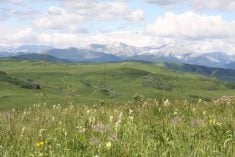El Nino has one more nasty surprise in store for prairie farmers: pestilence.
Insects that have plagued farmers south of the national divide are making their way north, even choosing to stay for the winter.
Lygus bugs have long spent winters in Canada’s West. They survive in weedy or woody areas, waiting for spring. The warmer the winter, the better they survive and last winter was one of the warmest.
“We expected a large population of lygus this season and it looks like we are going to get it. In sweeps of fall-seeded canola, it’s already blooming, we are finding them in significant numbers. It is going to be a serious threat to farmers’ crops this year,” said Murray Hartman, of Alberta Agriculture in Innisfail.
Read Also

Gene editing digs deeper space in Canadian plant breeding
More Canadian research into crop variety development is incorporating gene editing, and one researcher notes that Canada’s regulatory approach to gene editing will help drive innovation
The first generations of lygus populations have been found in blooming alfalfa crops and are expected to move onto canola as buds form. Until last year entomologists would expect to see only one significant generation of the insect pest. This year a second generation has begun to infest Canadian crops and scientists feel the warm weather may be to blame.
John Mayko, of the Canola Council of Canada, feels a combination of fall-seeded canola and an early-seeded spring crop will cause lygus that are feeding on alfalfa to move to feed on canola buds. A second generation will dine on the seedpods later in the season.
“These are just the right kind of conditions. Canola that has been planted near to alfalfa will be the hardest hit,” said Mayko.
Second generations complicate the decision of when to spray.
“Farmers can only afford to spray once for the insects so getting them when two large populations at different stages are most vulnerable to the spray is really important,” said Dennis Lee, an entomologist with Alberta Agriculture.
Lee suggests growers use sweep nets to check for lygus from the time the plants first become susceptible. At the bud and early-flowering stage, 15 lygus captured in 10 sweeps of the net is considered to be the economic threshold that determines it is time to spray.
When the plant has set pods, the number of insects increases to 20 per 10 sweeps. The oldest nymphs and adult lygus are responsible for crop damage, so producers wishing to spray only once will need to balance the numbers of insects and maturity stages when timing an insecticide application.
At the pod stage the presence of lygus can be diagnosed by checking for tiny, circular puncture wounds. As the number of lygus increases, growers will find small droplets of plant sap on the surface of the pods and if the populations are high enough the entire crop will seem to become sticky.
The testing involves sweeping a standard insect net 37 centimetres in diameter from side to side in a 180-degree pattern.
“In Alberta more than 400,000 acres were sprayed for lygus last year and that number is going to be higher this year,” said Lee.
Spraying usually takes place near the end of flowering when the upper seedpods are forming.
Agrologists suggest spraying late in the evening to avoid killing pollinating insects and using enough water to ensure canopy penetration.
Lygus use piercing, sucking mouthparts to attack canola buds. It is suspected the insects inject a toxin into immature flowers and that this later causes the “bud blasting” when the flower explodes after opening and a flower stem without pods develops. Feeding on seedpods causes shriveled, dark pods to form with fewer seeds and lower percentages of oil.
Once the seeds turn yellow or brown, lygus are no longer a threat to seed yields.
“Lygus won’t be the only insects interested in canola this year. We are seeing some new ones especially in southern areas. Beet webworm and cabbage seedpod weevils are also showing up in places north of their traditional homes,” said Lee.














